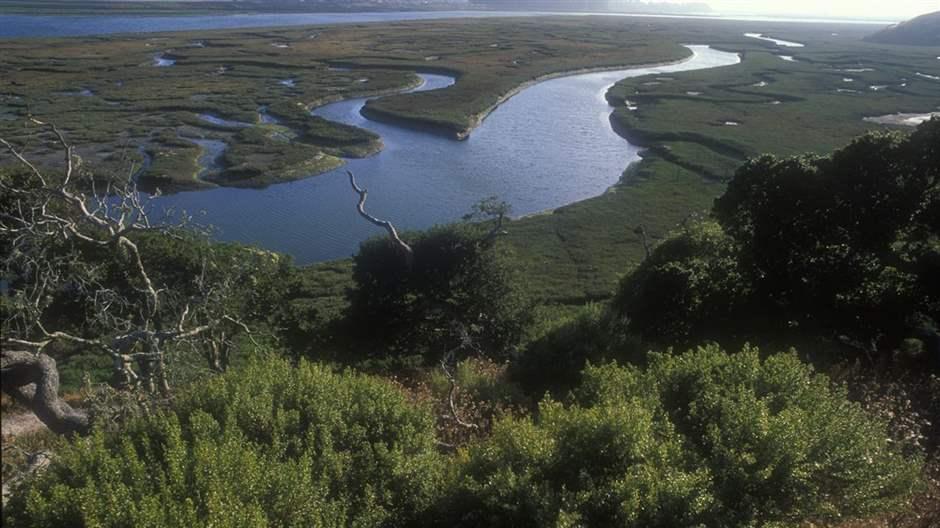In what’s becoming a distressingly familiar scenario, the scientific evidence that a natural ecosystem can help fight climate change is building just as that same habitat faces increasing threats from a warming planet. In this case, it’s “blue carbon” habitats—such as salt marsh and seagrass beds—which can capture and store significant amounts of carbon but are also imperiled by rising sea levels.
During a recent webinar hosted by The Pew Charitable Trusts, experts explored emerging research on how climate-induced changes are affecting these and other coastal landscapes, and options on how to best manage and conserve them.
The webinar—attended by about 150 representatives of state and federal agencies, nongovernmental organizations, and research institutions—was presented by Pew’s Blue Carbon Network, created in 2022 to strengthen connections among professionals working to conserve and expand blue carbon habitats through state governments, which have authority for most coastal governance.
Coastal management strategies to preserve blue carbon
Sea-level rise is a major threat to blue carbon-storing habitats, such as marshes and seagrass beds. And although marshes can adapt by either migrating inland or growing vertically, elevation and barriers such as roads, shoreline structures, and other development can impede this movement, leading to the erosion of marsh and the release of previously stored carbon, Molly Mitchell, research assistant professor with the Virginia Institute of Marine Science at the College of William & Mary, told attendees.
To counter this, coastal management officials could preserve land adjacent to marshes to allow their migration or restore coastal forests in areas less susceptible to sea-level rise, Mitchell said. To advance and support these efforts, more research is needed to better quantify existing blue carbon, improve forecasts about sea-level rise, and better understand what happens to carbon stored in coastal habitats when marshes drown because of sea-level rise.
“We do assume there are limits to the natural adaptability of marshes to sea-level rise, and management actions will be necessary to prolong and enhance blue carbon stocks out into the future,” Mitchell concluded.
Are “ghost forests” contributing to climate change?
Increasingly, U.S. coastal landscapes are home to “ghost forests”—the remnants of healthy forests ravaged by rapid saltwater intrusion and increased flooding caused by climate change-related events, such as sea-level rise, hurricanes, and drought. Sometimes, salt-tolerant marsh grasses replace coastal freshwater forests, but because of the release of stored carbon as trees decompose, this transition may result in a temporary net loss of stored carbon and increase the release of other greenhouse gases such as methane.
Initial research suggested that tree stems in ghost forests may serve as a type of straw, allowing the release of methane into the atmosphere from the degraded trees, said Melinda Martinez, a Mendenhall post-doctorate/research ecologist with the U.S. Geological Survey within the Wetland and Aquatic Research Center in Lafayette, Louisiana. What she and other scientists subsequently discovered is that while methane or carbon dioxide can be released through a tree stem, the overall impact may be mitigated because the dead wood in ghost forests still retains carbon and converts some of the methane back to carbon dioxide, a less potent greenhouse gas.
Elkhorn Slough managers address transitioning landscapes in blue carbon work
Elkhorn Slough, a tidal marsh and estuary in California’s Monterey Bay, provides habitat for hundreds of species of plants and animals. It’s one of 30 National Estuarine Research Reserves (NERR) throughout the U.S. and its territories. The slough historically captured significant amounts of carbon dioxide, but from around 1870 to 2000, about half of its marshlands were lost because of diking, while its remaining marshes began drowning and are unlikely to survive even minimal sea-level rise, Monique Fountain, director of the Tidal Wetland Program at the Elkhorn Slough NERR, told participants.
In response, conservationists and scientists there set out to study how blue carbon habitats can be better maintained. They explored several options, including conserving existing tidal marshes, facilitating marsh migration to higher ground, and adding sediment to restore the marsh. Their case study site within the slough was Hester Marsh, which restored 122 acres of degraded tidal marsh and gained 14 acres of new marsh through the restoration efforts, Fountain said.
However, because of the cost and time needed for large-scale restoration efforts, whenever possible, it’s better to prioritize maintaining healthy and intact marshes, she added.
Restoration is a complex, time-consuming process
The experts also addressed questions about the complex permitting process to restore vulnerable habitats and advised the audience to be prepared for a lengthy process and extensive collaboration among various permitting agencies.
“Our take-home message for planners and funders is to plan for tomorrow’s marshes far in advance and be patient,” Fountain said, adding that the Elkhorn Slough restoration effort involved upwards of 15 state and federal agencies. The panelists also stressed the need for continued research on what happens to sequestered carbon when a habitat “drowns” because of sea-level rise.
The most important action humanity can take to limit climate change is to reduce greenhouse gas emissions. But by moving immediately to protect natural assets such as salt marsh and coastal forests—and by taking steps to help ensure they thrive into the future—governments can further lessen the ill effects of climate change.
Sylvia Troost is a senior manager and Alex Clayton is a principal associate who work on incorporating blue carbon into climate action plans for The Pew Charitable Trusts’ conserving marine life in the United States project.
https://news.google.com/__i/rss/rd/articles/CBMijgFodHRwczovL3d3dy5wZXd0cnVzdHMub3JnL2VuL3Jlc2VhcmNoLWFuZC1hbmFseXNpcy9hcnRpY2xlcy8yMDIzLzAxLzMxL3RvLWJlc3QtZmlnaHQtY2xpbWF0ZS1jaGFuZ2UtYmx1ZS1jYXJib24taGFiaXRhdHMtbXVzdC1maXJzdC1zdXJ2aXZlLWl00gEA?oc=5
2023-01-31 15:30:00Z

Tidak ada komentar:
Posting Komentar